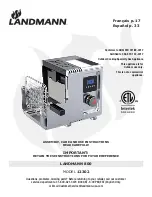
7 - English
WARNING:
Do not allow familiarity with products to make you
careless. Remember that a careless fraction of a
second is sufficient to inflict severe injury.
WARNING:
Always wear eye protection with side shields
marked to comply with ANSI Z87.1. Failure to do
so could result in objects being thrown into your
eyes resulting in possible serious injury.
WARNING:
Do not use any attachments or accessories
not recommended by the manufacturer of this
product. The use of attachments or accessories
not recommended can result in serious personal
injury.
APPLICATIONS
You may use this product for the purposes listed below:
Hammer drilling in concrete, brick, or other masonry
Drilling in wood
Drilling in ceramics, plastics, fiberglass, and laminates
Drilling in metals
CAUTION:
This drill is not intended to be used for mixing
concrete, drywall, grout or other similar types of
viscous mixtures. Failure to obey this caution could
cause poor performance, possible injury, and will
void your warranty.
SWITCH TRIGGER
See Figure 2, page 11.
To turn the drill
ON
, depress the switch trigger. To turn it
OFF
, release the switch trigger.
VARIABLE SPEED
The variable speed switch delivers higher speed with in-
creased trigger pressure and lower speed with decreased
trigger pressure.
NOTE:
You might hear a whistling or ringing noise from
the switch during use. Do not be concerned; this is a
normal part of the switch function.
DIRECTION OF ROTATION SELECTOR
(FORWARD/REVERSE)
See Figure 3, page 11.
The direction of bit rotation is reversible and is controlled
by a selector located above the switch trigger. With the drill
held in normal operating position, the direction of rotation
selector should be positioned to the left of the switch trigger
for forward drilling. The drilling direction is reversed when
the selector is to the right of the switch trigger.
NOTICE:
To prevent gear damage, always allow the chuck
to come to a complete stop before changing the
direction of rotation.
To stop the drill, release the switch trigger and allow the
chuck to come to a complete stop.
NOTE:
The drill will not run unless the direction of rotation
selector is pushed fully to the left or right.
Avoid running the drill at low speeds for extended periods
of time. Running at low speeds under constant usage may
cause the drill to become overheated. If this occurs, cool the
drill by running it without a load and at full speed.
TO INSTALL BITS
See Figures 4 - 5, page 11.
Unplug the drill.
Insert the chuck key and twist counterclockwise.
Open or close the chuck jaws to a point where the opening
is slightly larger than the bit size you intend to use. Also,
raise the front of the drill slightly to keep the bit from falling
out of the chuck jaws.
WARNING:
Make sure to insert the drill bit straight into the
chuck jaws. Do not insert the drill bit into the chuck
jaws at an angle then tighten, as shown in figure 5.
This could cause the drill bit to be thrown from the
drill, resulting in possible serious personal injury or
damage to the chuck.
Insert the drill bit.
Tighten the chuck jaws securely on the drill bit, using the
chuck key provided.
Remove the chuck key.
TO REMOVE BITS
See Figure 4, page 11.
Unplug the drill.
Loosen the chuck jaws using the chuck key provided.
Remove the drill bit.
Remove the chuck key.
OPERATION
Summary of Contents for R5013
Page 31: ...13 NOTES NOTAS...








































